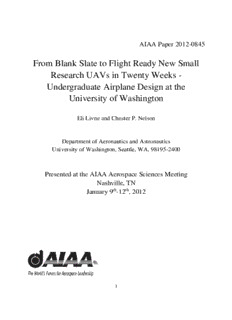Table Of ContentAIAA Paper 2012-0845
From Blank Slate to Flight Ready New Small
Research UAVs in Twenty Weeks -
Undergraduate Airplane Design at the
University of Washington
Eli Livne and Chester P. Nelson
Department of Aeronautics and Astronautics
University of Washington, Seattle, WA, 98195-2400
Presented at the AIAA Aerospace Sciences Meeting
Nashville, TN
January 9th-12th, 2012
1
From Blank Slate to Flight Ready New Small Research UAVs in
Twenty Weeks - Undergraduate Airplane Design at the
University of Washington
EliLivne*andChesterP.Nelson**
Departmentof AeronauticsandAstronautics
Universityof Washington,Seattle, WA,98195-2400
Abstract
The capstone airplane design course at the Universityof Washington, two academic quarters long, has evolved in
recent years to cover the airplane design experience from market and needs studies through conceptual design,
preliminary design, and detail design, and up to the construction, ground testing, and flight testing of complex
research-type small UAVs. Significant engineering resources are devoted to this effort including substantial CAD,
CFD-based aerodynamics, NASTRAN-based structural analysis, as well as performance, and stability and control
simulations.WindtunneltestsofcommercialqualitymodelsattheUniversityofWashington’sKirstenwindtunnel
are carried out, plus structural static and modal tests, airframe / propulsion system integration tests, together with
systems and system integration testing. An emphasis is placed on test / simulation correlation assessment and the
developmentinstudentsoftheappreciationofalternativenumerical/analyticmodelingmethods,theirstrengthsand
limitations, advantages and disadvantages. The course emphasizes team work, communication skills, leadership,
initiative,andinnovation.Itrunswithtightbudgetandscheduleconstraintswhichthestudentsmustmeet.Eachyear
a new design challenge is pursued leading to new and unique research UAVs. The program leverages the
University’s own wind tunnel labs, local flight test locations, and the availability of experienced mentors.
SignificantsupportfromtheBoeingCompanyandfromAeronauticalTestingService,Inc.(Arlington,Washington),
allows the students access to, and interaction with, world class experts in the various areas airplane design has to
cover.
Introduction
Howto developeffectiveairplane designeducationprograms inboththeundergraduateandgraduate curriculaisa
challenge all academic aeronautical / aerospace engineering programs face. The multidisciplinary nature of
aerospace engineering, with the many required courses that must cover the key disciplines involved, leaves little
room in the aerospace engineering curriculum for long sequences of inter-related airplane design courses required
for introducing students to airplane design in a thorough way. Such sequences should begin with reviews, from an
appliedperspective,ofwhatstudentshadcoveredearlieraswellasthefundamentalsofgeneraldesignandairplane
design, and they should end, desirably, with the completion of detailed designs and construction of new vehicles.
Even though aerospace engineering programs cover the fundamentals in aerodynamics, structures, propulsion,
control,as well as airplane performance and flight mechanics, undergraduate students often reach their senior year
without enough applied knowledge and experience in these disciplines and without the capacity for disciplinary
integrationandmultidisciplinaryperspective. Inadditiontothetheoreticalandpracticaltechnicalissuesinvolvedit
hasbeenlongrecognizedthatairplanedesigneducationattheundergraduatelevelistoprepareengineering
* Professor,[email protected]
**AffiliateAssociateProfessorandBoeingTechnicalFellow
2
Studentstransitiontoandenterprofessionallifeinthe“realworld”. Thismeansdevelopingexperiencewithand
appreciationforinnovation,communicationsandteamwork,alongwiththeimportanceofmarketneeds,
environmentalandsocialconsiderations,and,finally,projectmanagementanddecisionmakinginthefaceofreal-
worldanalyticaluncertaintyandexperimentallimitations,andoperatingwithinbudgetandscheduleconstraints.
Overthecourseofover15yearstheUniversityofWashingtoninSeattlehasbeendevelopinganundergraduate
airplaneprogramthataimsatmeetingthechallengeslistedabove.Thestateoftheprograminitsearlystageswas
reportedinRef.1,whichalsocoveredinitsbibliographygeneraldevelopmentsinandapproachestoairplanedesign
educationtotheendofthe1990s.References2-6hereareimportantarticlesdiscussingairplanedesigneducation
andreflectingawaveofinterestinthesubjectinthe1990s.References8-14representperspectivesandrecent
nationalandinternationaldevelopmentinairplanedesigneducation.ThepresentpaperdescribestheUniversityof
Washington’sprogramatitspresentstage.Asithasbecomeoneofthemostambitiousinternationally,itishoped
thatsomeofthelessonslearnedandexperiencegainedmaybeofinterestandhelptoothersstrugglingtodevelop
stateoftheartundergraduateairplanedesignprograms.
EducationalGoals&Approach
TheundergraduateairplanedesignprogramattheUniversityofWashingtonisaimedatandisstructuredfor
meetingthefollowinggoals.
Atthesenior(capstone)level:
a) Integrateallthatstudentshavecoveredintheconstituentdisciplinesintoacoherentbodyofknowledgethat
allowsstudentstoapplydisciplinaryknow-howtotheairplanedesigntaskandtoappreciatetheinter-connected
natureofthemultidisciplinaryinteractionsandconsiderationsinvolved.
b)Buildengineeringexperienceand“engineeringfeel”byusingahierarchyofanalytical/computationalmodeling
toolsineachofthecontributingdisciplines,andinsistingonboththeconstructionofphysicalmodelsandon
significantexperimentalworkthroughouttheproject.Thisallowsassessmentofstrengthandlimitationsofvarious
modelingapproaches,weighingtradeoffsbetweenmathmodelgeneration&analysisexecutionspeeds,andthe
accuracyofnumericalsimulationsasmeasuredbycorrelationwithexperiments.
c) Useindustrystandardlevelofnumericalsimulationandtesting,but,simultaneously,insistonusingsimple“back
oftheenvelope”andhandbooktypeestimatestoassessorderofmagnitudeofdesignchangeeffectsandtodetect
possiblemodelinginputerrorswhenresultsofhighlevelsimulationsaremuchdifferentinorderofmagnitudethan
backoftheenvelopeestimates.Examples:Usesimplebeamandplateequationstovalidateorderofmagnitudeof
detailedfiniteelementresults,usecomponentdragbuild-uphandcalculationmethodstocomparewithfullNavier-
StokesCFDsimulations,oruseDATCOMandNACAreporttypeapproximationsalongsidepanelcodeandCFD
codepredictionofstabilityderivatives.Inthisvein,allowstudentstobuildexperiencewithausefulhierarchyof
mathmodelingtechniqueslinkedtothestagesoftheevolutionofthedesignandtotimeandbudgetconstraints.
d) Providesignificanthands-onexperience:fromplanning,designing,andexecutingtestsofcomponentsand
subsystemsthroughcompleteconstruction,systemsintegration,andground&flighttestsofcomplexsmallUAVs.
IncorporatetheuseofprojectmanagementtoolsandbasicSystemsEngineeringprinciplesthroughouttheproject.
ToquoteLeCorbusier(Ref.15):“Teachingisonlypossibleintheverycentreofacraft.Arithmeticandhandwriting
canbetaughtinschools. Butaninventionoriginatesonlyintheworkshop.Thedooroftheworkshopopensupon
life.Thepracticalapplicationofcreatedthingsproducesanimmediateverdictastotheirworth.”
e) Providesignificantsystemsintegrationexperiencecoveringallaspectsofsystemsengineeringfromrequirements
andcomponentselectiontointegrationandpackagingdesign,implementation,iron-birdtesting,andfinaltestingon
3
thecompletedUAV.Systemsintegrationshouldcoveravionicsaswellasavionicsintegrationwiththeairframe,its
structure,dynamics,aerodynamics,andcontrol.
e) Createadesignanddevelopmentenvironmentrepresentativeofsuchenvironmentsinindustryandgovernment
agenciesandleadtostudenttransitionfromtheindividual,structured,andmicro-managedworldofthehighschool
andcollegestudenttotheworldofteamwork,collaboration,decisionmakinginthefaceofuncertainty,budget,and
scheduleconstraints.Encourageandguidethedevelopmentofmanagementandleadershipskills.
f) Nurtureinnovationandcontributiontotheprofessionbypresentingthestudentseachyearwithanewdesign
challenge,andbythedesign,construction,andtestingofsmallresearchUAVsthatareuniqueandthatallowwind
tunnelandflighttestingoftechnologiesthataretopicsofcurrentinterestandrelevancetoindustryandNASAfor
futureaircraftdesigns. Produce,attheendofeachdesignproject,qualitycomputationalandtestdataofpotential
researchvaluetofuturethesisprojects,governmentagenciesandtheaerospaceindustry.
Atthefreshmantojuniorlevels:
g) Includeanapplicationdesign-orientedelementinallaerospaceengineeringdisciplinarycourses.Thishastobe
carefullyplannedandbalancedtoaugmentandnothurtthebuildingofdepthandcoveringthefundamentalsinthe
disciplinarycourses.
h) EncouragestudentstoparticipateinAIAAdesign,build,fly(DBF)competitionsandgainexperienceviasimple
radio-controlmodeldesignanddevelopment.Suchearlyexperienceisveryvaluableeventhoughtheengineering
analysisandtestinginvolvedandtheconfigurationscreatedcanbequitelimitedindepth,scope,andcomplexity.
i)Introducestudentstoleadingexpertsfromindustryviaseminarseriesandinvitedclasstalks,andencourage
expert-studentmentoringandconsultinghelp.
Briefpresentationsofrecentcapstonedesignprojectsinthefollowingsectionswillbeusedtohighlightthekey
elementsoftheUniversityofWashington’scapstonedesigncourse,describeitsscope,andsharewiththereader
lessonsfromthedevelopmentinanundergraduateengineeringenvironmentofsomeveryinterestingUAVs.
UniversityofWashingtonCapstoneAirplaneDesignProjects2006-2011
ThevarietyofresearchUAVsdesigned,built,andflownbystudentsintheairplanecapstonedesigncoursesover
thelast6yearsareshowninFigure1.Thechallengeforthe2006classwastodesignandbuildascaledsupersonic
businessjetconfigurationUAVtohelpinvestigatecriticallow-speedflyingqualitiesandfieldperformance
characteristicsofveryslenderconfigurations.In2007theclasswastaskedwiththeconversionofaNASAF16-XL
toalowsonicboomresearchplatformaircraft,withfocus,again,ontheviabilityoftheresultinglow-speedflight
characteristicswithsuchadrasticmodification.TheinterestinthemodifiedF16-XLasalowsonic-boomresearch
vehiclewasdrivenin2005-2006 byNASAandindustry’spursuitoflow-costflightvehiclewithsupersoniccruise
capabilitytomeetresearchneedsinthisarea. In2008thefocusofthedesigncourseshiftedtosubsonicairplanes
andthechallengetothestudentswastodesign,build,andflyaUAVrepresentingasubsonicregionaljetconcept
configuredforlownoisebyusingairframesurfacestolargelyshieldengineinletandexhaustnoisefromground
observers.The2006-2008UAVsusedelectricductedfan(EDF)propulsorstosimulateturbofanengines.Thedesign
challengesin2009and2010focusedondevelopingturbojetpropelledUAVsforresearchregardingthesubsonic
handlingqualitiesandpropulsion-airframeintegrationissuesoffuturesupersonicpassengerjetsconfiguredfor
engine-airframenoiseshielding(similartoconceptsinNASA’sFundamentalAeronauticsProgram “N+2/N+3”
aircrafttechnologystudies).Returningtosubsoniccommercialflight,the2011designprojectfocusedonveryhigh
aspectratiofuturesubsoniccommercialairlinersusingstrut-bracedortruss-bracedwings.Theresultingscaleddown
UAVwasagainpropelledbyelectricductedfanstosimulateveryhighbypassratiogearedturbofan(GTF)engines.
4
This2011UAVwasconstructedwithanaeroelasticallyscaledflexiblewingandcanserveasatestbedforfollow-
onaeroelasticflighttestsofalternativewing/strutandwing/trussdesigns.
AllUniversityofWashingtonUAVsofthelastfewyearsflewsuccessfullyfromtheNavy’sCoupevilleOLF air
striponWhidbey,Island,WA.The2007UAVdidsufferaloss-of-controlcrashduetoinstabilitiesathighanglesof
attackbutwasnotheavilydamaged. Thisincidentofferedthestudentteamsomecruciallessonsaboutthe
importanceofchecklistsandcarefulCGlocationtrackingduringflighttestsofpotentiallyunstableconfigurations.
Figure1:UniversityofWashingtoncapstoneairplanedesignUAVs2006-2011(note:thedifferentpicturesarenot
tothesamescale).
The2006UniversityofWashingtonCapstoneDesignProject
Initially,adiscussionofthe2006capstoneprojectwillprovideanoverviewofthetypicalclass. Thedesign
challengetothestudentsofthe2006capstoneairplanedesignclasswastodevelopaconceptual12seat,Mach1.6,
4000NMsupersonicbusinessjet(SSBJ)design,havingaveryslendergeneralarrangementrepresentativeoflow
sonicboomdesignrequirements.Thefinenessratiowasspecifiedtobeappropriateforagroundlevelboom
overpressureof0.35psforaboutan85%sonicboomreductionrelativetoConcorde. ThefullscaleresultingSSBJ
designconcepthadthentobescaleddowndynamically,andthestudentswerechallengedtodesign,build,andflight
testalowspeedUAVforstudyingitshandlingqualitiesandflightcharacteristicsattakeoff,approach,andlanding
conditions.FollowinglessonsfromthedevelopmentofHSCTandothersupersonicexamplesstudentsspenta
considerableamountoftimestudyingthestabilityandcontrollabilityofalternativewing/controlsurfaceplanforms
5
usingahierarchyofaerodynamicsimulationtechniquesfromacommerciallinearpanelcodetononlinearNavier-
StokesCFDsimulations(Fig.2).
Figure2:PanelcodeandSTAR-CCM+Navier-StokesCFDsimulationsofthe2006SSBJdesign.
Afinalbaselineconfigurationwasdown-selectedoutofthematrixofalternativesandwasfurtherdevelopedto
convergethevehiclesizing,definethepreliminaryoutermoldline(OML)aerodynamiccontours,propulsionand
structuralarrangement,estimatedmassproperties,andmajorsystemsandinteriorfeatures.Basedonthisfullscale
configurationconcept,adynamicallyscaledUAVwasdesigned,includingstructurallayout,selectionofmaterials
basedonavailabledataanddedicatedcoupontests,systemsneedsdefinition,andtheselectionof commercially
adaptablepropulsion,landinggear,controls,andallcommunicationandflighttestinstrumentationsystems.Awind
tunnelmodelwasbuiltbyAeronauticalTestingService,Inc.(ATS),includingpartsforalargenumberofplanform
andcontrolsurfacevariations,andwindtunneltestswerecarriedoutattheUniversityofWashington’sKirsten12ft
x8ftlowspeedwindtunnel. Suchtestsarecrucialforthelow-speed/highangleofattackaerodynamicevaluation
ofsupersonicconfigurations,wherevortexsheddingandvortexbreakdownmayplayasignificantroleandcanbe
hardtocaptureaprioriusingCFD.Similarly,testsofkeyUAVstructuralcomponentsareusuallycarriedouteach
year(staticallyanddynamically)tovalidatefiniteelementstructuralmodels.
Figure3:A2006modelofasupersoniccruiseconfigurationinstalledattheUniversityofWashington’s12’x8’low
speedKirstenWindTunnel(left)withChinaClayflowvisualizationpatternsatahighangleofattack(right).
WiththeconclusionofthewindtunnelteststhefinalUAVconfigurationwasfrozenandUAVdetaildesigncould
proceed,followedbyconstruction,systemsintegration,systemstests,groundtests,andfirstflightofthevehicle.
6
Figure3showsthewindtunnelmodelinoneofitsconfigurationsattheKirstenWindTunneltogetherwithaChina
Clayflowvisualizationpatternrepresentingaparticularangleofattackandtunneldynamicpressure.Studentsinthe
capstoneairplanedesigncoursesingeneralspendaconsiderableamountoftimeworkingwiththewindtunnel
modelinthetunnelduringtestsanddevelopinggreaterinsightsintotheaerodynamicissuesinvolved.Theyare
requiredtocorrelatemeasuredwindtunnelresultswithCFDandhandbookpredictionswhichusuallyresultsin
improvementstotheconfiguration,improvementstotheCFDsolutions,orboth. CFDhasalsobeenhelpfulin
understandingconfiguration-specificwindtunnelsupportinterferenceandtunnelwalleffects.
Duringthewindtunneltestsofthe2006configurations622runswerecarriedoutover11shifts.Variationsofthe
testedconfigurationsincludedthreeoutboardwingplanforms,twocanardplanformsinfourlocations,twostabilizer
sizesattwoheights,outboardwinddihedralvariations,droopedleadingedgeandtrailingedgecontrolsurfaces,
forebodychines,twoverticaltailchordsandruddersattwolongitudinallocations.Thetestsalsocoveredground
effects,andthrusteffects(withanEDFpowerednacelle)incompleteangleofattackandside-slipanglesweeps.
Figure4:ACADdefinition(Unigraphics)and FEMAP/NASTRANmodelsof the2006UAV.
AUnigraphicsCADdefinitionofthe2006UAVandarear¾-viewimageofitsFEMAP/NASTRANmodelare
presentedinFigure4,whilepicturesshowingtheconstructionoftheUAVareshowninFigure5.Theoutershellof
theairframeismadeofKevlarcloth/Epoxylayups.Thewingribs,spars,bodykeels,andbodyframesareofcarbon
fiber/EpoxyandDivinycell-coresandwichconstruction.Thenosegearmountisastudent-designedmachined
aluminumstructureandmostotherfittingsandfastenersaremetal.Thelargersizeandhigherdesignairspeedsof
theUWcapstoneUAVsprovidesexperiencewithmoderncompositeconstructionsimilartothatoffull-scale
aircrafttoamuchgreaterextentthanispracticalonthemodest,lowercostradiocontrolledfoamandbalsawood
modelsusedinDBFcompetitionsorindesigncoursesthatspliteachclassintomultipleDBF-likeprojects.
Studentsmustchoosetheirmaterialsandstructuralarrangementforfabricationandassemblyconsiderationsaswell
asstrength,stiffness,andlightweight.Classroomstructurestheory,load-paths,stressconcentrations,andfastener
edgemargins,andsystemsaccessibilitytakeontangibleimportancefortheUAVelementofthecourse---lessons
thatarenoteasytoteacheffectivelyin“paperstudyonly”typedesigncourses.
Akeyairframedesigndecisioniswhetheritisbettertodesignacomponentwithhighdamagetolerance(butusually
moredifficultfabricationorhigherweight)versusdesigningforeasierreparability(orreplacement). Priorto2009,
Kevlar/EpoxywasextensivelyusedinUniversityofWashingtonUAVstohelpminimizedamagetotheairframein
caseofacrash(especiallywhenpitch-up-sensitiveaerodynamicallynonlinearconfigurationswerebeing
investigated).Withgrowingconfidenceintheprogram’scapabilitytodesignandflycomplexsmallUAVs
successfullytheKevlaroutershelldesignphilosophywasreplacedbylighterweightoptimizedGlass/Epoxyskins,
withbothGraphiteandKevlarstillusedforinternalstructurewherebeneficial.
7
AsFigure5shows,theUniversityofWashington’sUAVsarebuiltcompletelybythestudentsusingwetlayupinto
femalemouldsmachinedfromtoolingfoambyATSbasedonthestudents’UAVCADmodel,orusingmalemoulds
builtdirectlybythestudents.NCwater-jetcutmetaltemplatesareusedasguidestofabricatingsomesub-
componentssuchaspre-contoureddull-depthfoamcoresforglass-skinnedtailsurfaces.Thehands-onconstruction
experiencesupportedbycoupontests,structuraltestsofcomponents,andstructuraltestsofthecompletevehicle
offerthestudentsinsightandend-to-endprojectexperienceregardingairframedesign,compositeconstruction,math
modelingtechniquesandtheirusesandlimitations.
Figure5:Kevlar/EpoxyandGraphite/EpoxyConstructionoftheUniversityofWashington’s2006UAV.
Figure5alsoshowsthe120mmsizedelectricductedfanusedtopropelthe2006UAV.Whiletheconfiguration
selectedanddevelopedwasa3-engineairplane,onlyonelarge14-15lbfthrustEDFwasusedontheUAVscenter
nacelleforpropulsion.Windtunneltestsincludedpoweredtestswiththecenterengineoperatinginthewindtunnel
andthetwowingnacelleinletsdomed-over.Motorhighertemperaturesthanexpectedduringoperationwere
reducedbythestudentteamusingasetofcoolingfinsquicklydesigned,built,attachedtothemotor,andtestedin
thewindtunnel.
Theas-built2006UAVis9.5ftlong,4.5ftinspan.Itweighs30lbsandhasathrusttoweightratioof0.5.Itswing
referenceareais7.06ft2anditswingloadingis4.25psf.Itisa6.76%scaledmodelofthefullconfiguration.
8
Figure6:The2006UniversityofWashington’sslenderSSBJconfigurationresearchUAV
AnX-PlanesimulationmodelandtheactualUAVinflightareshowninFigure7. X-Planeisacommercially
availabledesktopPCbasedflightsimulatorthathasbeenusedeffectivelyinthecapstoneairplanedesigncoursefor
flightstabilityandcontrol(S&C)instructionandrapidevaluationoftheconfigurationalongitspathof
development.Usesofthissoftwarehaveexpandedasthesimulationpackagehasbecomemorecapableinlater
versions,includingforpre-flighttestrehearsaloftheUAVsoperation.Pilotedsimulatoruseisaugmentedlaterin
theprojectbyMatlab/SimulinksimulationsdrivenbyCFDandwindtunnelbasedaerodynamicdata.
Figure8showsthenominalclassschedulewhichtargetsthecompletionofaflight-readyUAVatthe20weekpoint.
WhileeveryeffortismadetotestflytheUAVbefore“finalsweek”,thecompletedUAVroll-outdate,weather,test
facilityavailability,andotheruncontrollablefactorscandelayUAVfirstflightdatesbeyondthefinalweek(atno
gradepenaltytothestudents). Initialtestsofthe2006UAVidentifiedsomeneededsystemsmodificationsbut
unfortunatelyoccurredtoolateintheacademicyeartoallowforadditionaltestoutingsduringthecourse.Needed
modificationsweresubsequentlycarriedoutandtheUAVwasfinallysuccessfullydemonstratedin2008.
Figure7:AnX-Planesimulationmodelofthe2006UAVandtheactualUAVinflight.
9
Mar Mar May May May May Jun
# ListofActivties StartDurStartDurDone 1 2 3 4 5 6 7 8 9 10 11 12 13 14 15 16 17 18 19 20 21 22 23 24
Weeks-
Setupteamsand
getmissionreq. •
1 1 1 1 1 100%
BasicA/CDesign
Training •
2 1 3 1 3 33%
ConstructionSkill
Training
3 2 11 2 11 0%
NoiseTraining
4 2 8 2 8 0%
CFD/StarCCM
Training
5 3 4 3 4 0%
CADTraining
6 4 5 4 5 0%
Planform
Integratedinto
StarCCM
7 6 3 6 3 0%
Propulsion
Familiarization
8 6 5 6 5 0%
NoiseTesting
9 8 8 8 8 0%
FinalExterior
DesignSet
10 9 1 9 1 0%
PreliminaryDesign
Review
11 9 1 9 1 0%
FinalCADToATS
12 10 1 10 1 0%
InternalDesign
Process
13 10 5 10 5 0%
PropulsionDesign
andConstruction
14 10 5 10 5 0%
FinalConstruction
15 13 6 13 6 0%
WindTunnel
Testing
16 13 2 13 2 0%
PropulsionReady
toIntegrate
17 15 1 15 1 0%
FlightTesting
18 19 1 19 1 0%
FlightswithData
Recording
19 20 2 20 2 0%
DataReduction
andAnalysis
20 22 2 22 2 0%
Presentation
Preparation
21 23 1 23 1 0%
Figure8:Atypicalplannedscheduleforthecapstonedesigncourse(afewactivitiesareomittedforbrevity).
StructureandScheduleoftheCapstoneAirplaneDesignCourse
Withthe2006projectinmindasanexample,wecanfurtherconsiderthestructureandscheduleofthecapstone
courseasithasevolvedtothepresentform.AttheUniversityofWashingtonstudentsarriveatthecapstoneairplane
designcourseatthebeginningofthewinterquarteroftheirsenioryear.Thecoursespanstenacademicweeksofthe
winterquarterfollowedbytenacademicweeksofthespringquarter,fromthebeginningofJanuarytoMidJune(24
calendar-weekselapsedtime). Thestudentsbringwiththem,usually,adiversemixofpriorexperiencesinthekey
disciplinesaffectingairplanedesign,thedesignprocessitself,andtheconstruction,instrumentation,andflyingof
smallUAVs.SomewouldhavesomepriorR/Cmodeldesignexperiencethroughparticipationinearlieryearsin
10
Description:University's own wind tunnel labs, local flight test locations, and the . 4000 NM supersonic business jet (SSBJ) design, having a very slender general

